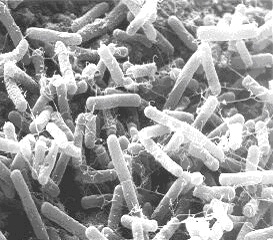3.
Dark-fermentation by bacteria
Hundreds of bacterial strains can produce hydrogen by (dark) anaerobic fermentation of chemical compounds. The [FeFe]-hydrogenases, then, function to dispose of excess electrons accumulated during fermentation (Peters, 1999). Carbohydrates are the most attractive substrates but proteins, organic acids and alcohols may also be used. These bacteria are either facultative anaerobic or strict anaerobic (oxygen being toxic for growth). The highest hydrogen producers amongst facultative anaerobic bacteria are the enterobacteriaceae species. Their typical conversion efficiency is about 0,85 mol H2/mol hexose. Typical conversion efficiencies of the strict anaerobic hydrogen producers, mainly Clostridium species, are 1.9–2.5 mol H2/mol hexose (Lay, 2001; Ueno et al., 2001; Fang and Liu, 2002). In one study, continuous H2 production achieved a yield of 2.7 mol H2/glucose using a mixed culture of Clostridium butyricum and Enterobacter aerogenes (Yokoi et al., 2002).

Clostridium Enterobacter
The biogas contains about 50% and
70% hydrogen, respectively, and carbon dioxide as other major component. Traces
compounds are also present in the biogas. However, they have a relatively low
effect, if any, on the biogas end-user. Indeed, according to experimentations
carried out at CWBI,
direct feeding of a PEM fuel cell with biogas
(0,8-liter per hour, 70% H2 – 30% CO2) was successful. As shown on
Figure 2, acid and alcohol compounds are sub-products of
carbohydrates metabolism. However, as demonstrated at CWBI with pure
Clostridium strains, successive removal of a specific fraction of
sub-product mixtures and addition of fresh medium can lead to the production of
the sole acetate and butyrate metabolites. Furthermore, they can be degraded by
classical
biomethanization. Therefore, no
inhibitory compounds would be produced by H2 - producing bacteria
Different optimisation factors have been investigated in literature and
by CWBI. The most critical affecting hydrogen production rates and yields is H2
partial pressure (Mizuno et al., 2000).
In classical hydrodynamic conditions i.e. gentle mixing without
gas stripping, the maximum hydrogen production rate achieved per unit of
bioreactor volume is generally about 10-15 mmol H2/l.h. Indeed, most
of these studies emphasize that biogas transfer out of the liquid phase is
limited in aqueous reactors without intensive stirring (Rachman et
al., 1998). However, while stirred reactors facilitate gas
release from the liquid phase, continuous stirring of the reactor consumes
considerable electric power. The energy needed for mixing in anaerobic
wastewater treatment reactors ranges from 85 to 105 kW/1000 m³ (Grady et al.,
1999).
Aiming at a better biogas transfer, it has been found in
batch tests that continuous release of the biogas from the system can increase H2
yields by as much as 40% (Logan et al., 2002). Results of the experiments
carried out in the CWBI have achieved H2 production rate six times
higher when CO2 was continuously injected in medium during glucose
fermentation in 15L bioreactor. However, since inert gas such as CO2
present in biogas is unfavourable for the hydrogen end-users yields, such as PEM
fuel cell, gas stripping should be avoided. Other important physico-chemical
parameters to master are pH, temperature, and concentrations in organic or
ammonium nitrogen and sub-products.
Various types of bioreactors have been studied for biohydrogen production by dark fermentation of carbohydrates e.g.
batch :
Van Ginkel et al., 2001; Logan et al., 2002; Oh et al., 2003,
fed-batch : Chin et al., 2003,
continuous-flow stirred tank : Fang and Liu, 2002; Hussy et
al., 2003,
upflow granulated reactors : Liu and Fang, 2003, Chang and
Lin, 2004
membrane bioreactor : Oh et al., 2005
saturated packed-bed column reactors : Rachman et al.,
1998; Yokoi et al., 1997; Chang et al., 2002; Palazzi et al., 2002;
Lee et al., 2003, Wu et al., 2005
unsaturated trickle bed reactor : Oh et al., 2004, Zhang et
al., 2006.
